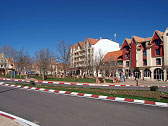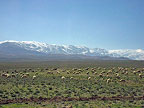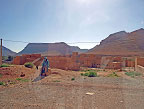FRANKFURT | CASABLANCA | ROAD TO FEZ | FEZ | ROAD TO ERFOUD | ONWARD TO OUARZAZATE | ROAD TO MARRAKECH | MARRAKECH | TUNISIA | CARTHAGE | DOUGGA/BULLA REGIA | DUBAI | AL MAHA | OMAN | SALALAH |
ROAD TO ERFOUDAs I said in an earlier, the travel agent decided that seeing Africa by car was superior to flying between the various points on our tour (maybe because the trip by small plane, even assuming there were airports, would be less than reliable). So we drove for almost seven hours from Fez to Erfoud.We went through three distinct landscapes: a low mountain range that supplied  the water for Fez, a higher range with a high desert plateau, and the desert. The mountains that supplied the water for Fez and the surrounding region are dotted with cedar forests and pasture land. It looked very rural and familiar, until we got to Ifran, which is in the mountains. Among other unusual aspects, it looks like a European city transplanted to Morocco, and it has a university affiliated with Georgetown. Ifran is a winter sports center, since it is in the Moroccan snow belt, and the ski resort is apparently very popular. the water for Fez, a higher range with a high desert plateau, and the desert. The mountains that supplied the water for Fez and the surrounding region are dotted with cedar forests and pasture land. It looked very rural and familiar, until we got to Ifran, which is in the mountains. Among other unusual aspects, it looks like a European city transplanted to Morocco, and it has a university affiliated with Georgetown. Ifran is a winter sports center, since it is in the Moroccan snow belt, and the ski resort is apparently very popular.
 We then went through high desert, bordered on one side by the Middle Rif Mountains. Here the pasturing of goats and sheep is the only agriculture possible. We then went through high desert, bordered on one side by the Middle Rif Mountains. Here the pasturing of goats and sheep is the only agriculture possible.  Wool, hides and meat are shipped to local cities for final processing, which shipment is often accomplished by donkey. Housing in this area varies between goat hair tents and the ubiquitous adobe box, square and low to the ground. The clay, which looks exactly like southwest US adobe, is mixed with pieces of straw and then formed into bricks after which that same mixture is spread over the brick walls like plaster. You can tell when the adobe needs repair: the little pieces of straw start sticking out like a fuzzy head of hair. The weather in this area ranges from freezing to hot as hell. Luckily, we had temperate/cool weather. Wool, hides and meat are shipped to local cities for final processing, which shipment is often accomplished by donkey. Housing in this area varies between goat hair tents and the ubiquitous adobe box, square and low to the ground. The clay, which looks exactly like southwest US adobe, is mixed with pieces of straw and then formed into bricks after which that same mixture is spread over the brick walls like plaster. You can tell when the adobe needs repair: the little pieces of straw start sticking out like a fuzzy head of hair. The weather in this area ranges from freezing to hot as hell. Luckily, we had temperate/cool weather.
 The land on the back side of the Rif mountain range is predominantly desert, but there are degrees of desert. Where there is a river or an oasis, there is life. Where there is no water, there's a desert with scrub vegetation and nomads with their flocks. The land around the rivers looks like a slice of Southern California, palm trees and cacti. Each family owns a slice of the land to the river on which they grow dates and olives. As the land cannot support the whole family, members leave the area to find work, often abroad, and are expected to send money back to the family. The land on the back side of the Rif mountain range is predominantly desert, but there are degrees of desert. Where there is a river or an oasis, there is life. Where there is no water, there's a desert with scrub vegetation and nomads with their flocks. The land around the rivers looks like a slice of Southern California, palm trees and cacti. Each family owns a slice of the land to the river on which they grow dates and olives. As the land cannot support the whole family, members leave the area to find work, often abroad, and are expected to send money back to the family.
 Our hotel was in the middle of nowhere. It looked like a Santa Fe, New Mexico transplant. In fact its name, Xaluca, is Andalusian, as in Andalusia in Spain. (Moors were expelled from Spain in the late 1400's after centuries of living there. Our hotel was in the middle of nowhere. It looked like a Santa Fe, New Mexico transplant. In fact its name, Xaluca, is Andalusian, as in Andalusia in Spain. (Moors were expelled from Spain in the late 1400's after centuries of living there.
The Internet in this hotel was advertised to be wireless and it was, if you went to the Reception desk. Tech support was very erratic: the hotel lost internet connection overnight. But on second thought, maybe a large Smithsonian traveling group can be blamed for crashing the system. A Smithsonian group has been traveling to the same places we have since Casablanca. The camel in the picture is not part of that group, however. It belongs to the hotel. |
|
| TURKEY AND GREECE | CIRCLE THE ARCTIC |